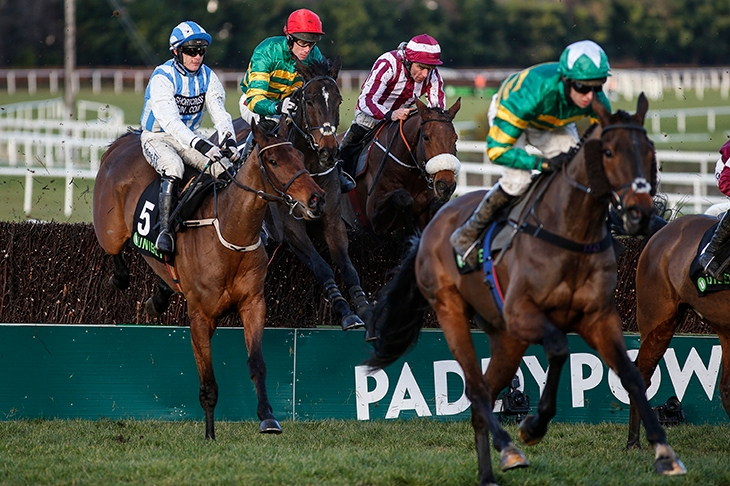‘Deer-stalking would be a very fine sport,’ W.S. Gilbert once observed, ‘if the deer had guns too.’ We who love jump racing have to acknowledge that there are plenty of folk out there who feel that horses, too, are helpless victims with no alternative but to hurl themselves at obstacles to profit heartless owners, trainers and riders. Trying to change the minds of such critics is probably akin to urging Jacob Rees-Mogg to stand a round for the EU’s Jean-Claude Juncker, but I just wish that some of racing’s critics could have been in the winners’ enclosure at Kempton last Saturday.
Nobody watching Amy Murphy’s bold-jumping Mercian Prince soar over every obstacle in a 2m 4f chase, meeting every fence with the perfect mixture of elan and precision, could fail to appreciate that he was enjoying the experience every bit as much as his talented rider Jack Quinlan. When little Top Notch, an eight-year-old who has been racing for five seasons from Nicky Henderson’s Seven Barrows yard in Lambourn, was asked by Daryl Jacob to go on and win his race from Black Corton and Charbel there was no doubt either about his continued relish for a contest. But what the anti-racing brigade should have seen was the emotion displayed by the two trainers afterwards. Champion trainer Nicky Henderson, who has won everything worth winning bar a Grand National, said of Top Notch: ‘I was worried they might have gone too quick for him on this fast ground, setting his little feet scampering, but he always had them covered, he is so brave.’ The Henderson yard is stuffed with expensive equine talent such as Gold Cup winner Might Bite, Champion hurdler Buveur d’Air and the unbeaten Altior, but Nicky declared that if a straw poll were taken among his team, then Top Notch would come out No. 1 every time: ‘There’s not a nicer horse in the place.’
It was the same story from the upcoming Amy Murphy. Sometimes worried that Mercian Prince is overshadowed by her star performer Kalashnikov, she was buzzing with pride: ‘I simply adore this horse. He helped to put us on the map and he has jumped them ragged. There simply is not a better jumper of fences.’ You can’t invent that sort of anthropomorphic affection.
Racing has entered the new year with the wagons circled. The controversy over whip use is raging again. The study into the deaths of six horses at the last Cheltenham Festival, which recommends 17 changes, has highlighted welfare concerns, and gambling legislation has raised fears about the sport’s funding stream. Against that background, the decision by Paul and Clare Rooney, racing enthusiasts with 120 horses spread across more than 20 yards, to order their trainers not to run horses at Cheltenham will have given a huge boost to the critics. Cheltenham is the Mecca of jump racing: its March Festival is the climax of every season, the ultimate source of fame and glory. The moment a horse shows a flicker of real talent, most owners ask their trainers: ‘Have we got one for Cheltenham here?’
The Rooneys, who lost Starchitect to a broken leg at Cheltenham in 2017 and Melrose Boy after injuries sustained there in 2018, are thoughtful, caring people, not loudmouths or eager controversialists. They have every right to take the decision they have done with regard to their own horses, but I am sad nonetheless that they have done so because of the way it will be exploited by racing’s enemies. Having not long ago written a history of the Cheltenham Festival, I have no doubt that it is one of the best-managed courses in Britain. There is no better clerk of the course anywhere than Cheltenham’s Simon Claisse and the Cheltenham team could not be more sensitive than they are to the welfare of both horses and jockeys. Remember the story of Edwulf, the horse who collapsed with an out-of-rhythm heartbeat after the final fence of the National Hunt Chase at the 2017 Festival? He was treated for over an hour by a team of vets counting 150 years of experience between them and the last race was delayed to help their efforts. Ten months later, Edwulf, termed by the media ‘the miracle horse’, won the Irish Gold Cup at Leopardstown.
In jump racing there will be falls and injuries to horses and jockeys. If there is any added risk at Cheltenham, it could be for the same reason that the injury rate among those training for England rugby internationals is higher than that among those training for club matches. The competition is that little bit more intense: everything happens a split second quicker and so latent injuries are more likely to be exposed. What is not the reason for injuries at Cheltenham is any kind of neglect by its officials. Every year Simon Claisse and his team comb through the evidence from each completed Festival and ask if there is any new action needed to improve welfare provisions. We should expect no less and no more than that.






Comments